
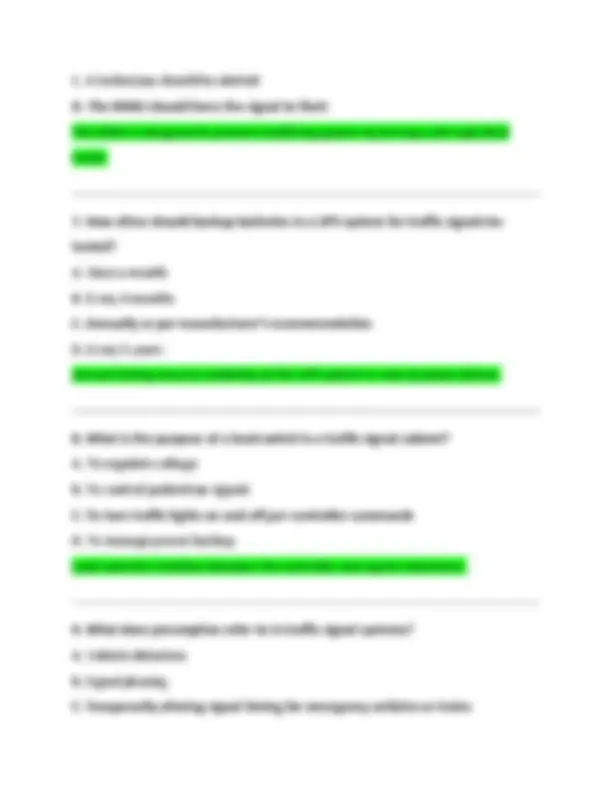
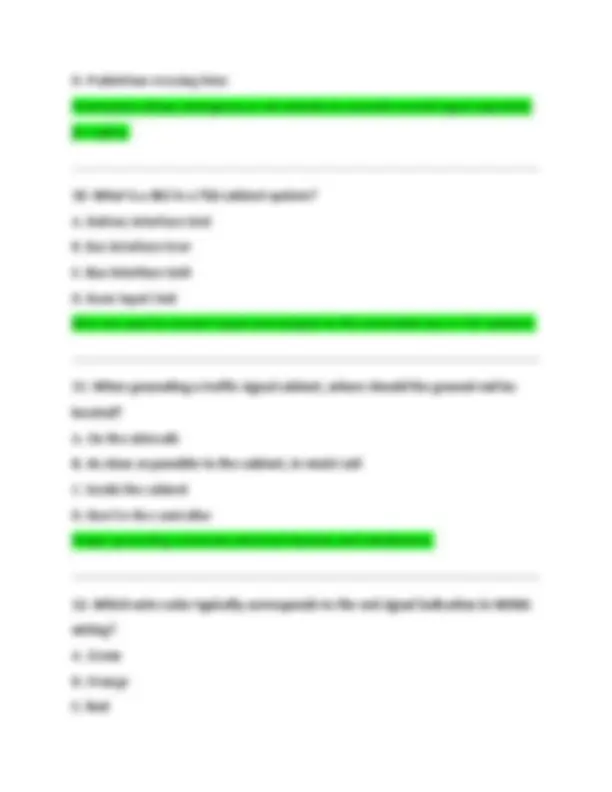
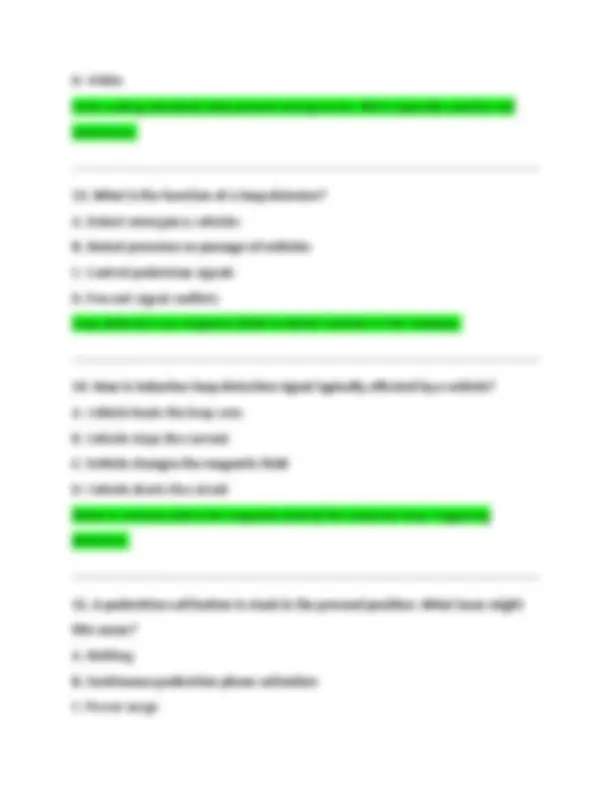
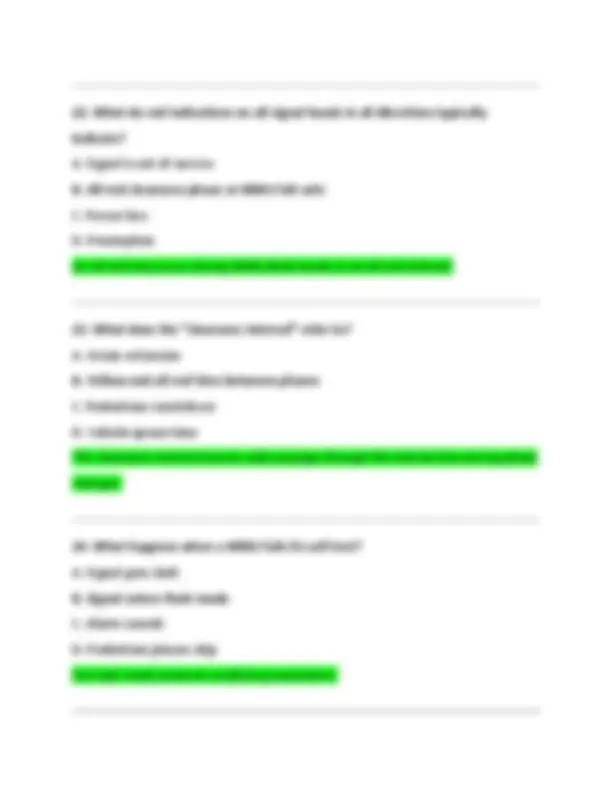
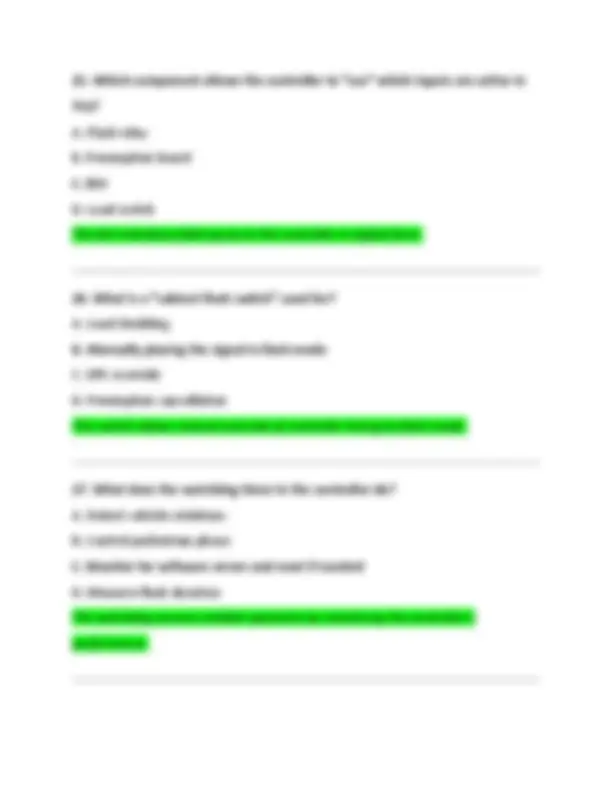
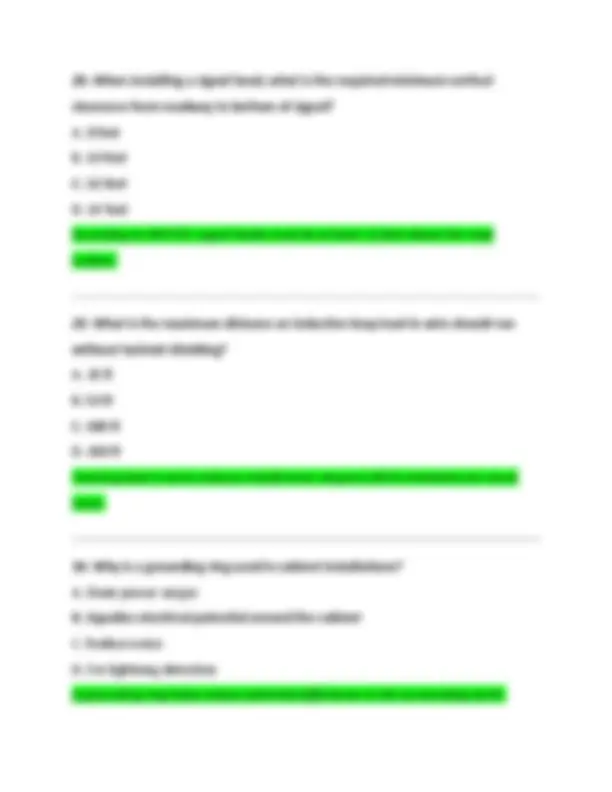
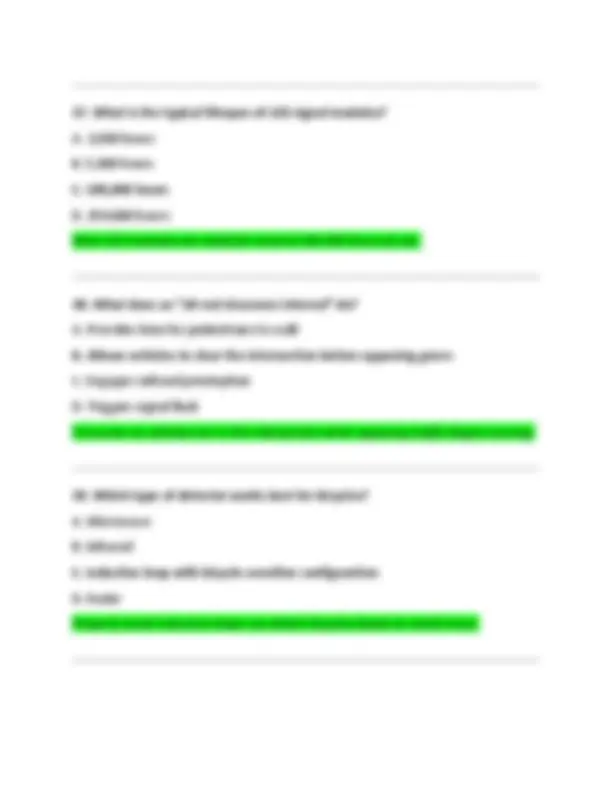
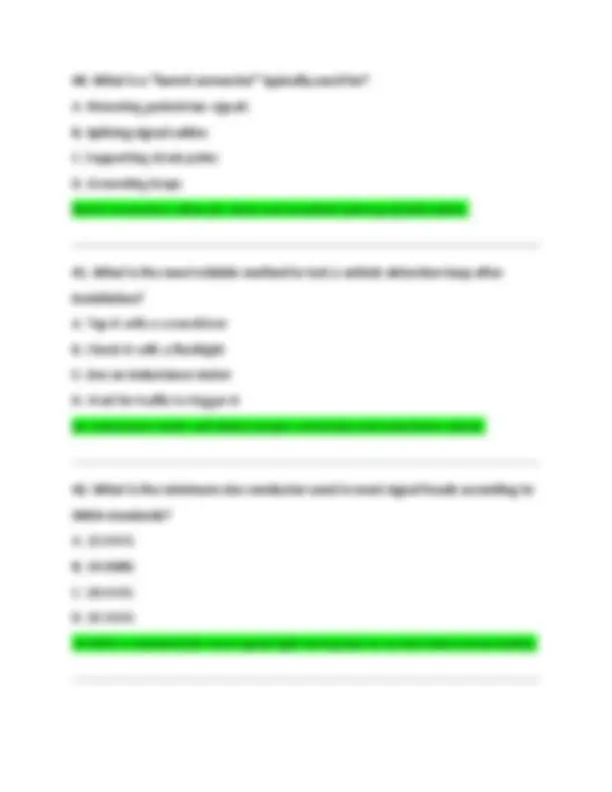
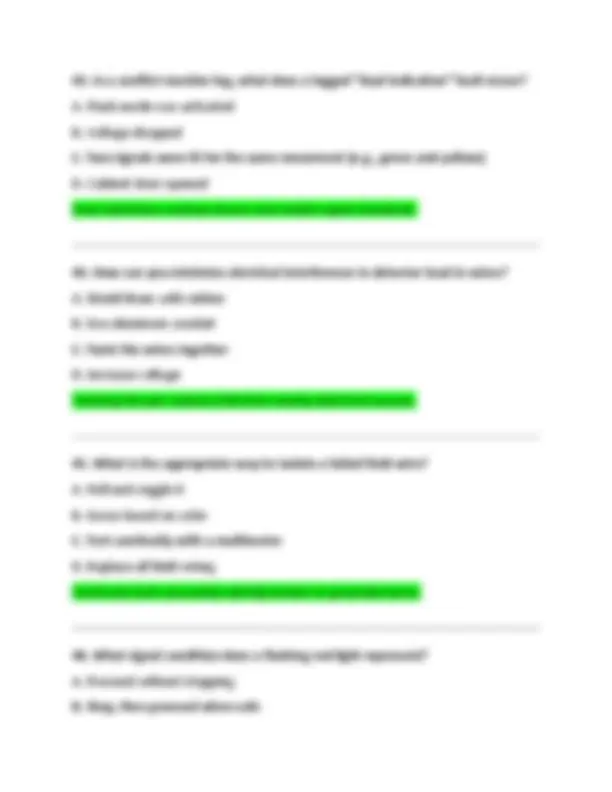
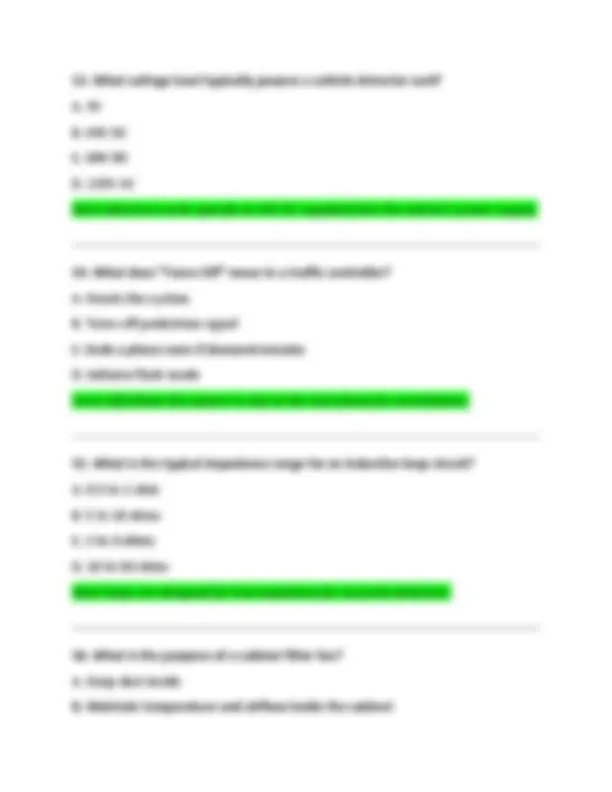
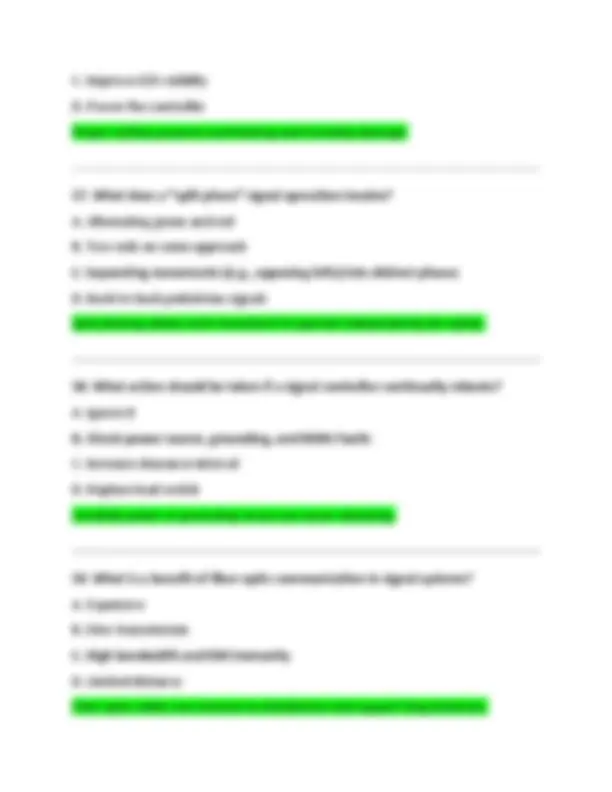
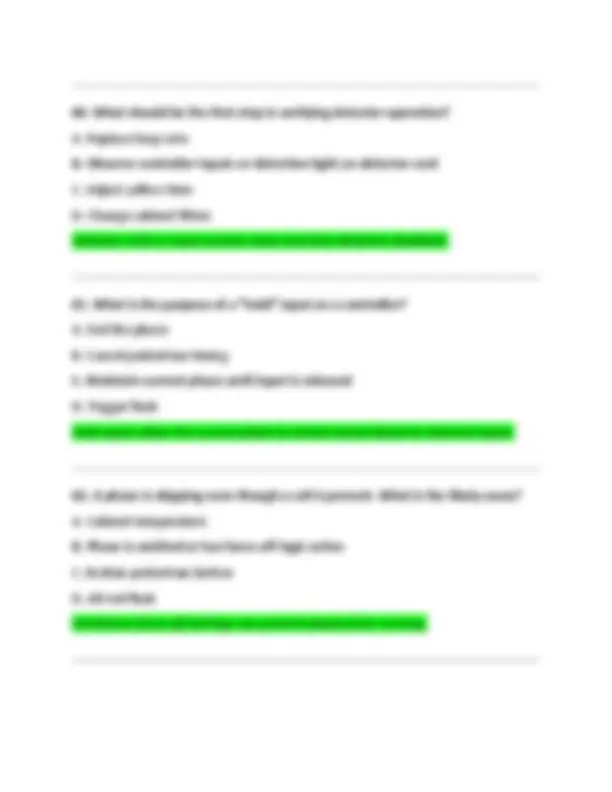
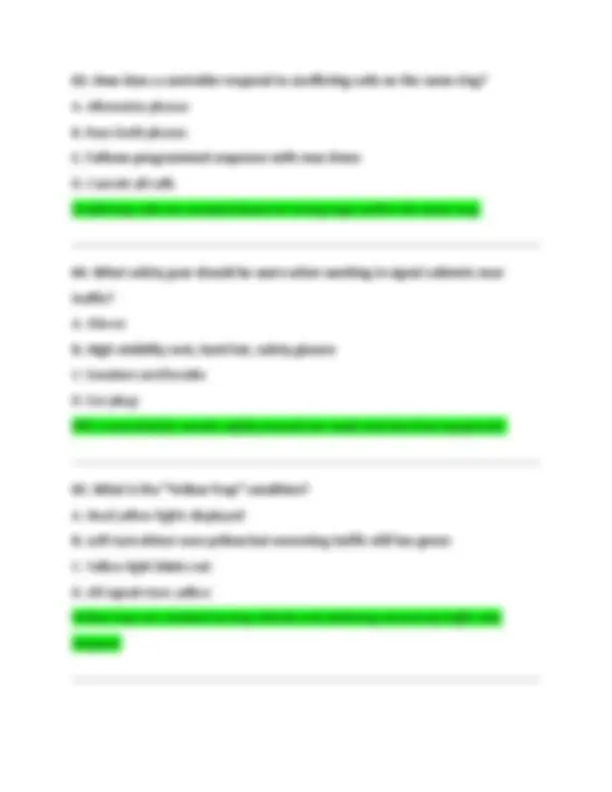
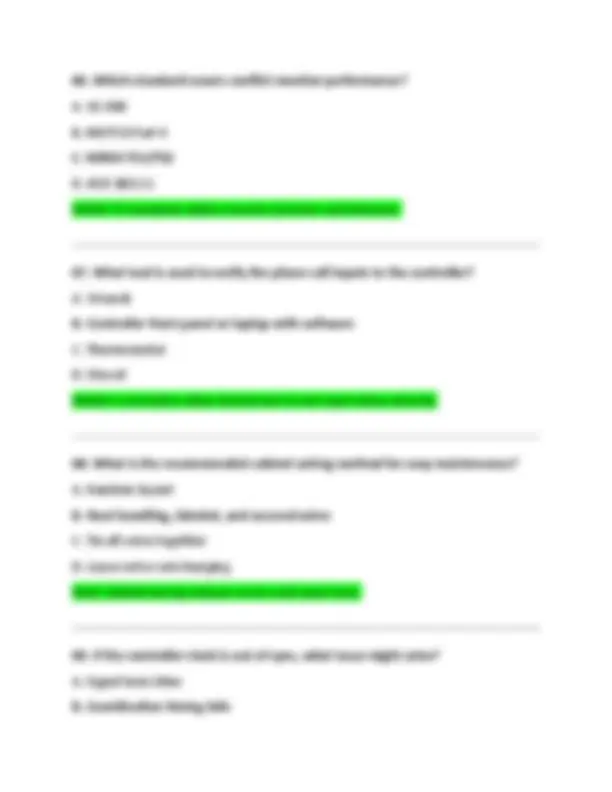
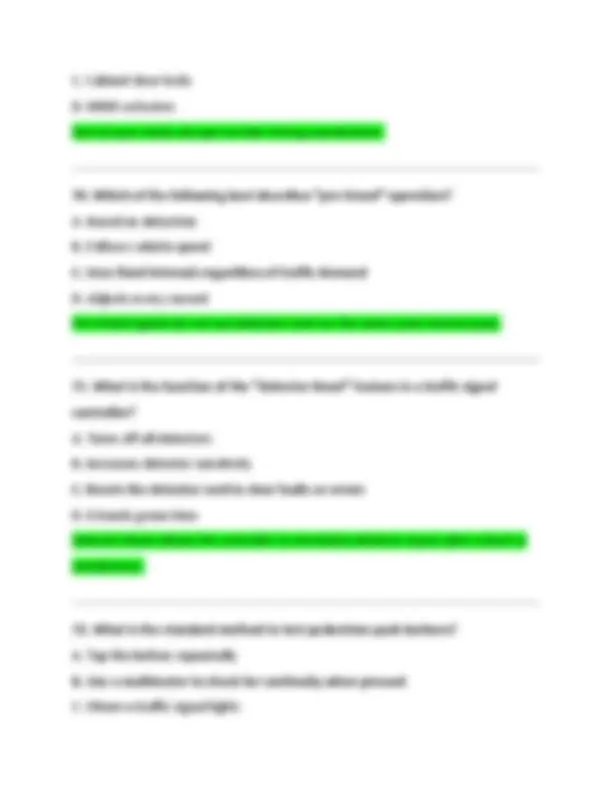
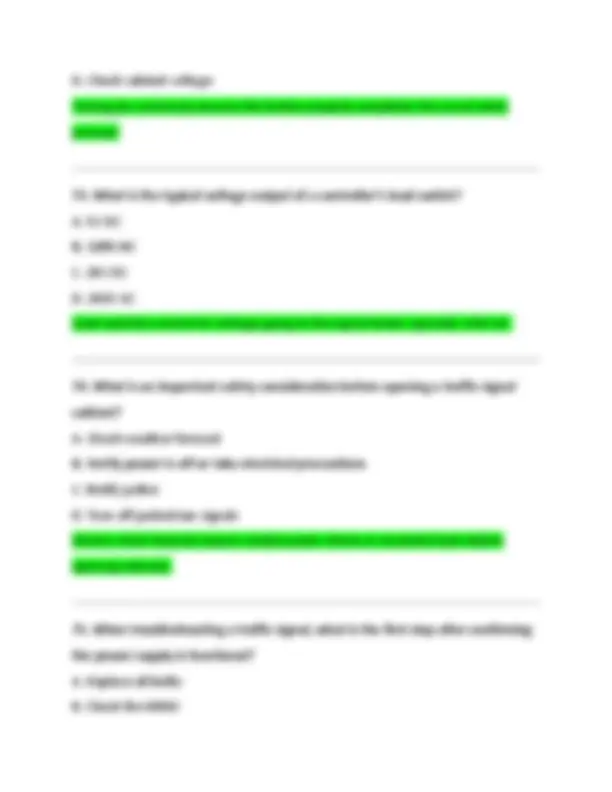

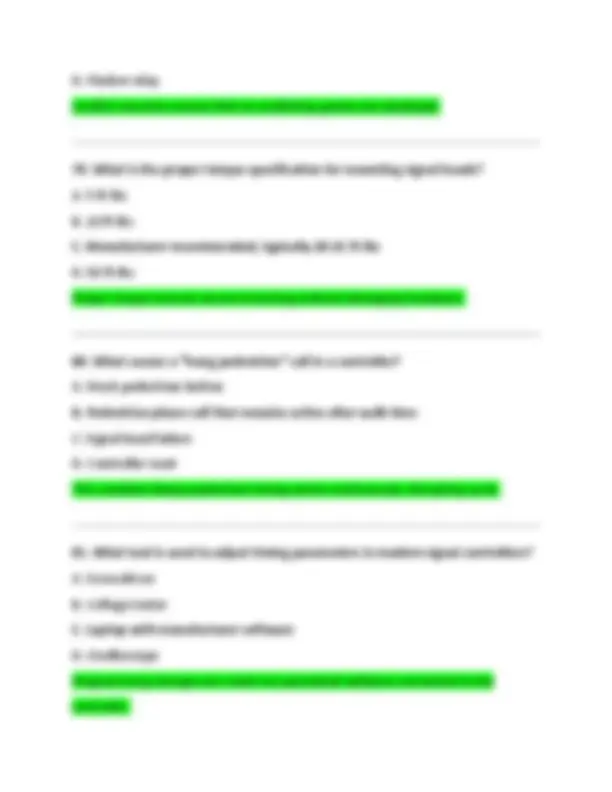
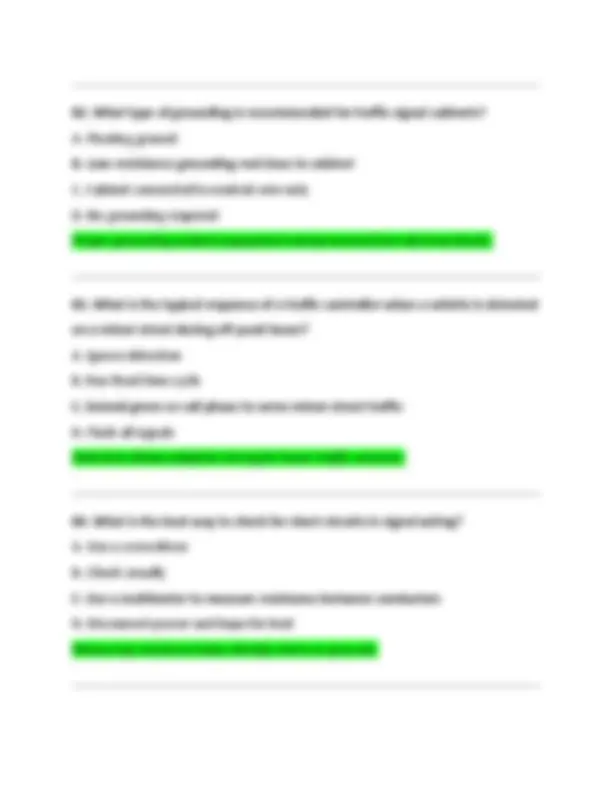
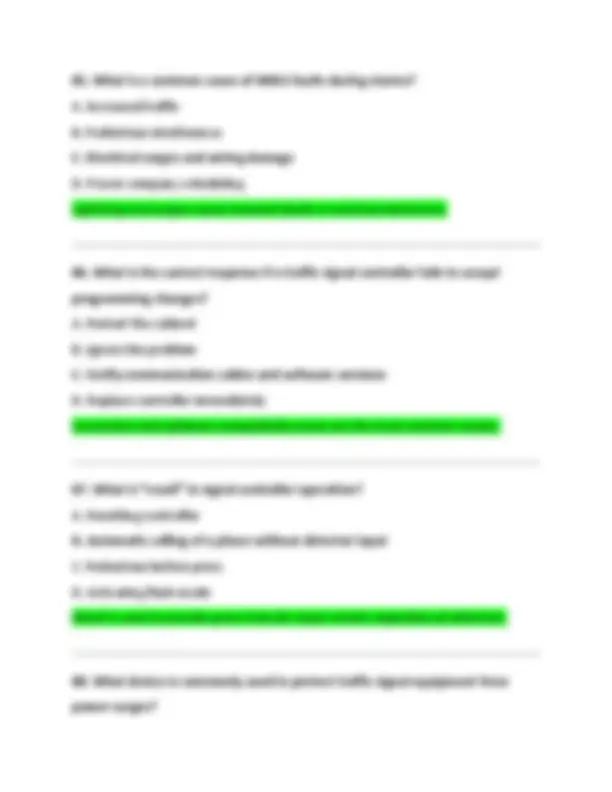
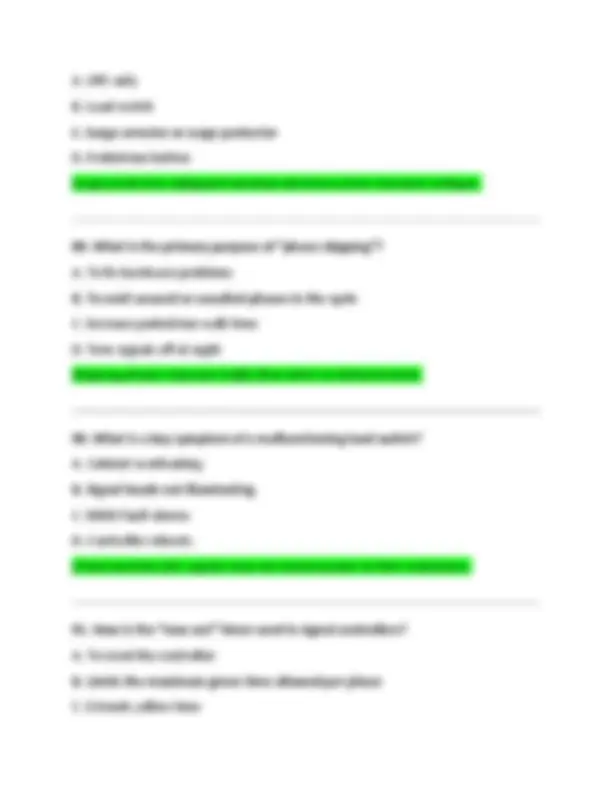
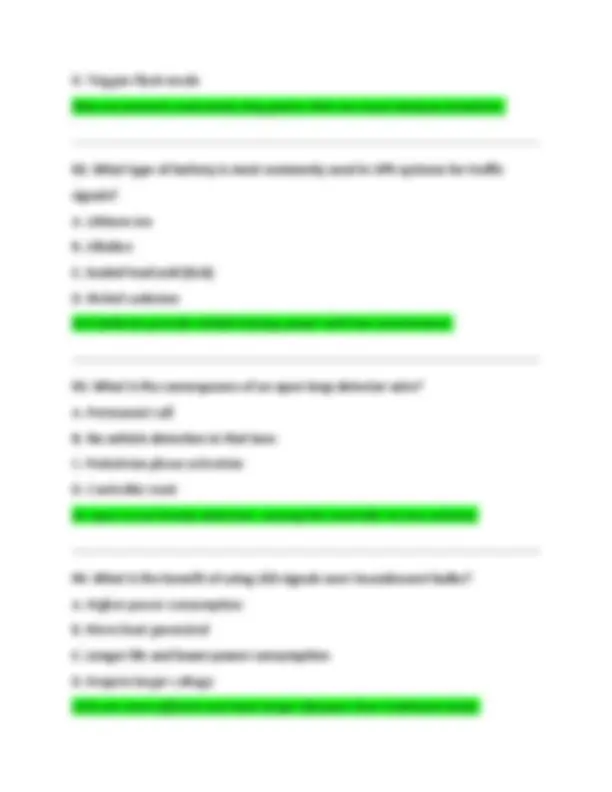
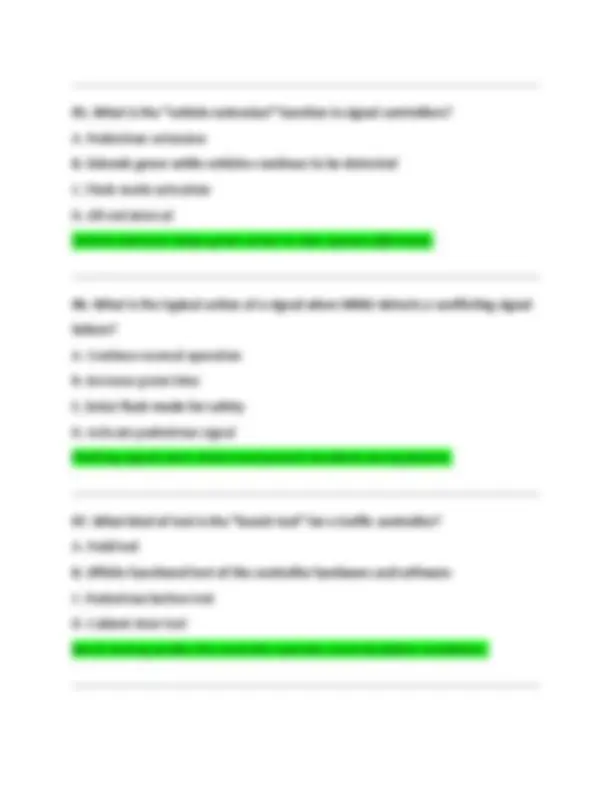
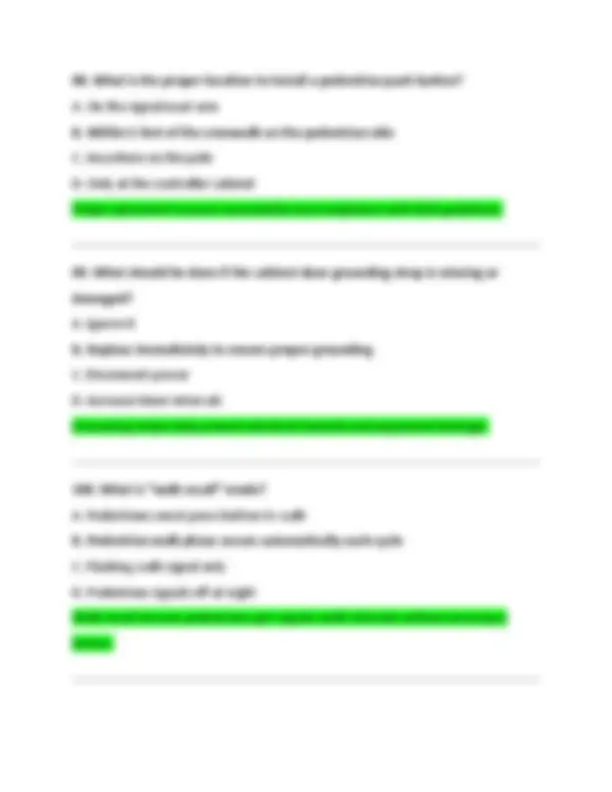
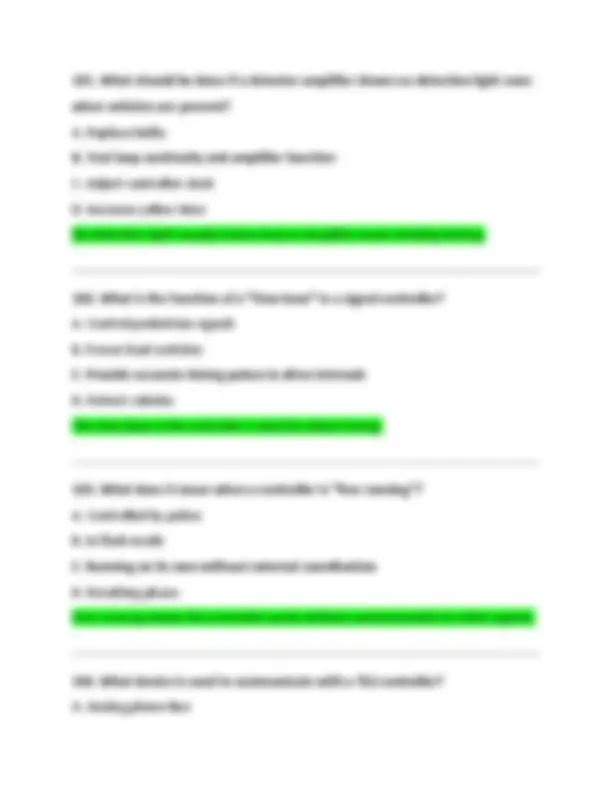

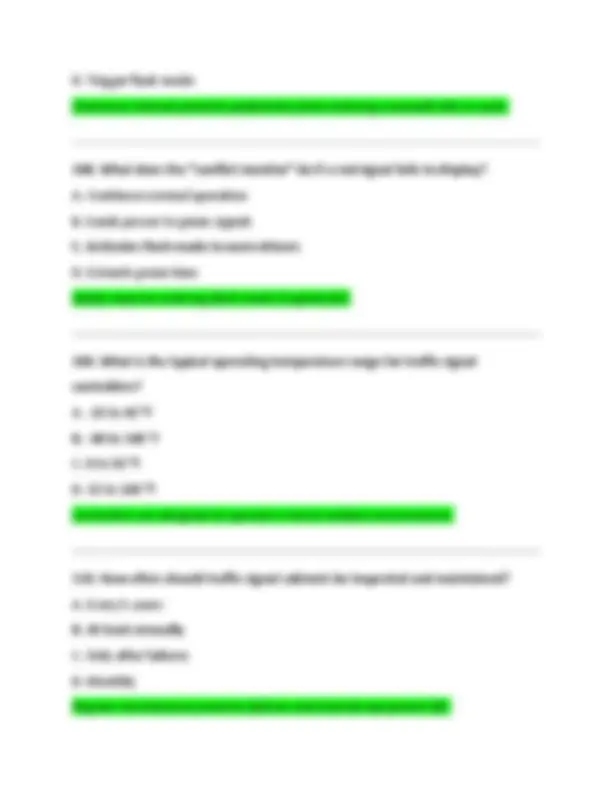



Study with the several resources on Docsity

Earn points by helping other students or get them with a premium plan


Prepare for your exams
Study with the several resources on Docsity

Earn points to download
Earn points by helping other students or get them with a premium plan
Community
Ask the community for help and clear up your study doubts
Discover the best universities in your country according to Docsity users
Free resources
Download our free guides on studying techniques, anxiety management strategies, and thesis advice from Docsity tutors
IMSA Traffic Signal Field Technician II Exam Questions And Correct Answers (Verified Answers) Plus Rationales 2025 Q&A | Instant Download
Typology: Exams
1 / 36

This page cannot be seen from the preview
Don't miss anything!





























1. What is the primary purpose of a traffic signal conflict monitor? A. To regulate pedestrian crossing times B. To detect and prevent conflicting signal indications C. To monitor vehicle speed D. To control railroad preemption timing A conflict monitor ensures that two opposing green signals are not displayed simultaneously, which could cause accidents. 2. What does a flashing yellow arrow typically indicate? A. Stop before turning B. Protected turn C. Yield to oncoming traffic before turning D. No turn allowed A flashing yellow arrow allows a left turn but requires yielding to oncoming traffic and pedestrians. 3. What does MUTCD stand for? A. Manual for Urban Traffic Control Devices B. Manual on Uniform Traffic Control Devices
C. Measurement Unit for Traffic Control Deployment D. Municipal Urban Traffic Control Design The MUTCD sets the national standard for all traffic control devices in the U.S.
4. What is a NEMA TS2 cabinet used for? A. Housing power transformers B. Housing traffic signal controllers and equipment C. Housing vehicle detectors D. Mounting pedestrian signals NEMA TS2 cabinets contain the controller, MMU, detectors, and related components for signal operation. 5. What is a MMU in traffic signal terminology? A. Multi-Modal Unit B. Motor Monitoring Unit C. Malfunction Management Unit D. Manual Mode Utility A Malfunction Management Unit detects conflicting or faulty signals and places the intersection in flash mode. 6. What should happen if a red signal fails and a green is displayed to conflicting traffic? A. Nothing; this is normal B. The green should continue
D. Pedestrian crossing time Preemption allows emergency or rail vehicles to override normal signal operation for safety.
10. What is a BIU in a TS2 cabinet system? A. Battery Interface Unit B. Bus Interface User C. Bus Interface Unit D. Basic Input Unit BIUs are used to connect inputs and outputs to the serial data bus in TS2 cabinets. 11. When grounding a traffic signal cabinet, where should the ground rod be located? A. On the sidewalk B. As close as possible to the cabinet, in moist soil C. Inside the cabinet D. Next to the controller Proper grounding minimizes electrical hazards and interference. 12. Which wire color typically corresponds to the red signal indication in NEMA wiring? A. Green B. Orange C. Red
D. White Color-coding standards help prevent wiring errors. Red is typically used for red indications.
13. What is the function of a loop detector? A. Detect emergency vehicles B. Detect presence or passage of vehicles C. Control pedestrian signals D. Prevent signal conflicts Loop detectors use magnetic fields to detect vehicles in the roadway. 14. How is inductive loop detection signal typically affected by a vehicle? A. Vehicle heats the loop wire B. Vehicle stops the current C. Vehicle changes the magnetic field D. Vehicle shorts the circuit Metal in vehicles alters the magnetic field of the inductive loop, triggering detection. 15. A pedestrian call button is stuck in the pressed position. What issue might this cause? A. Nothing B. Continuous pedestrian phase activation C. Power surge
D. Loop detector The flasher relay allows signals to enter flash mode safely.
19. Which of the following is a major difference between NEMA TS1 and TS standards? A. TS1 uses metal cabinets B. TS2 uses serial data communication C. TS1 does not use LEDs D. TS2 is incompatible with preemption TS2 cabinets use serial data communications for more efficient operations. 20. Which tool is most appropriate to measure loop detector inductance? A. Ammeter B. Oscilloscope C. Inductance meter D. Voltmeter An inductance meter measures the loop’s inductance in microhenries. 21. What is the most common cause of intermittent vehicle detection? A. Power outage B. Signal conflict C. Broken or poorly sealed loop wire D. MMU malfunction Water intrusion or damaged loop wire insulation leads to erratic detection.
22. What do red indications on all signal heads in all directions typically indicate? A. Signal is out of service B. All-red clearance phase or MMU fail-safe C. Power loss D. Preemption An all-red may occur during MMU flash mode or an all-red interval. 23. What does the "clearance interval" refer to? A. Green extension B. Yellow and all-red time between phases C. Pedestrian countdown D. Vehicle queue time The clearance interval ensures safe passage through the intersection during phase changes. 24. What happens when a MMU fails its self-test? A. Signal goes dark B. Signal enters flash mode C. Alarm sounds D. Pedestrian phases skip Fail-safe mode prevents conflicting indications.
28. When installing a signal head, what is the required minimum vertical clearance from roadway to bottom of signal? A. 8 feet B. 10 feet C. 12 feet D. 14 feet According to MUTCD, signal heads must be at least 12 feet above the road surface. 29. What is the maximum distance an inductive loop lead-in wire should run without twisted shielding? A. 25 ft B. 50 ft C. 100 ft D. 200 ft Twisting lead-in wires reduces interference; beyond 100 ft untwisted can cause noise. 30. Why is a grounding ring used in cabinet installations? A. Drain power surges B. Equalize electrical potential around the cabinet C. Reduce noise D. For lightning detection A grounding ring helps reduce potential differences in the surrounding earth.
31. What does the term "interval" refer to in a traffic signal controller? A. The pedestrian walk time B. A period during which specific signal indications are displayed C. Controller reset period D. Loop detection window An interval defines a segment of time (like green, yellow, or red) during a phase cycle. 32. What is a “phase” in a traffic signal controller? A. A flash sequence B. A pedestrian cycle C. A specific movement (e.g., left turn or through movement) assigned signal time D. A cabinet temperature cycle A phase defines one direction of movement at the intersection that receives right- of-way. 33. What tool is best for measuring current on a live AC circuit in a signal cabinet? A. Oscilloscope B. Clamp-on ammeter C. Volt meter
37. What is the typical lifespan of LED signal modules? A. 2,000 hours B. 5,000 hours C. 100,000 hours D. 250,000 hours Most LED modules are rated for around 100,000 hours of use. 38. What does an “all-red clearance interval” do? A. Provides time for pedestrians to walk B. Allows vehicles to clear the intersection before opposing green C. Engages railroad preemption D. Triggers signal flash It ensures no vehicles are in the intersection when opposing traffic begins moving. 39. Which type of detector works best for bicycles? A. Microwave B. Infrared C. Inductive loop with bicycle-sensitive configuration D. Radar Properly tuned inductive loops can detect bicycles based on metal mass.
40. What is a “barrel connector” typically used for? A. Mounting pedestrian signals B. Splicing signal cables C. Supporting strain poles D. Grounding loops Barrel connectors allow for clean and insulated splicing of field cables. 41. What is the most reliable method to test a vehicle detection loop after installation? A. Tap it with a screwdriver B. Check it with a flashlight C. Use an inductance meter D. Wait for traffic to trigger it An inductance meter will detect proper continuity and inductance values. 42. What is the minimum size conductor used in most signal heads according to IMSA standards? A. 22 AWG B. 14 AWG C. 18 AWG D. 10 AWG 14 AWG is standard for most signal light wiring due to current load and durability.
C. Yield to pedestrians D. No turn on red A flashing red acts like a stop sign.
47. When is a time-based coordination plan typically used? A. For pedestrian crosswalks only B. During signal flash C. To coordinate green lights along a corridor based on time of day D. In cabinets without MMUs Time-of-day coordination helps improve traffic flow across major roads. 48. What’s the purpose of a harness in a signal cabinet? A. Supports cabinet doors B. Prevents vandalism C. Organizes and routes wires D. Times pedestrian signals Harnesses keep wiring neat, organized, and easy to trace for maintenance. 49. What should be checked first when signal indications are dark? A. The conflict monitor B. Power supply and breaker panel C. Loop detectors D. Controller program Loss of power is the most common reason for signals to go dark.
50. What is “Green Extension” or “Max 1” timing used for? A. Extending pedestrian time B. Holding yellow indication C. Extending green when vehicles are still being detected D. Resetting signal phases Max 1 timing allows more green time based on vehicle presence. 51. What is the function of the Flash Transfer Relay? A. Sends voltage to pedestrian signs B. Converts AC to DC C. Switches between normal operation and flash mode D. Times all-red clearance It transfers control of outputs between controller and flasher. 52. Which communication method is most often used in coordinated signal systems? A. DSL B. Bluetooth C. Fiber optic or Ethernet D. Coaxial cable Modern systems rely on fast, low-latency fiber or Ethernet networks.
C. Improve LED visibility D. Power the controller Proper airflow prevents overheating and humidity damage.
57. What does a "split phase" signal operation involve? A. Alternating green and red B. Two reds on same approach C. Separating movements (e.g., opposing lefts) into distinct phases D. Back-to-back pedestrian signals Split phasing allows each movement to operate independently for safety. 58. What action should be taken if a signal controller continually reboots? A. Ignore it B. Check power source, grounding, and MMU faults C. Increase clearance interval D. Replace load switch Unstable power or grounding issues can cause rebooting. 59. What is a benefit of fiber-optic communication in signal systems? A. Expensive B. Slow transmission C. High bandwidth and EMI immunity D. Limited distance Fiber optic cables are immune to interference and support long distances.
60. What should be the first step in verifying detector operation? A. Replace loop wire B. Observe controller inputs or detection light on detector card C. Adjust yellow time D. Change cabinet filters Indicator LEDs or input screens show real-time detection feedback.
61. What is the purpose of a "hold" input on a controller? A. End the phase B. Cancel pedestrian timing C. Maintain current phase until input is released D. Trigger flash Hold inputs allow the current phase to remain active based on external inputs. 62. A phase is skipping even though a call is present. What is the likely cause? A. Cabinet temperature B. Phase is omitted or has force-off logic active C. Broken pedestrian button D. All-red flash Omitted or force-off settings can prevent phases from running.